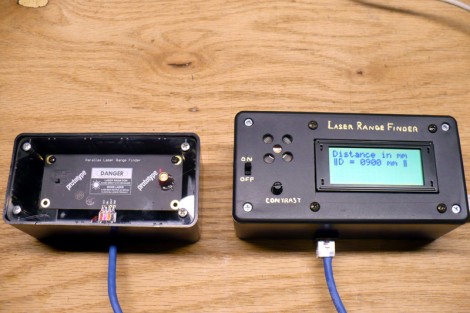
[Dino’s] project of the week is a backup alarm for your car. This is a feature that has become popular on many large vehicles like SUVs where visibility is an issue when moving in reverse. But it doesn’t sound like he was motivated by the need to have this in his own car. Instead, he was looking for something to build using a laser range finder.
[Joe Grand] (the brains behind DEFCON badges) has been working on an inexpensive laser range finder for Parallax. He sent one of the first-run prototype boards to [Dino] for beta testing and we’re glad that [Dino] decided to show it off. It uses a small red laser diode and a camera module to measure distance in millimeters. The board communicates serially and this particular project uses an Arduino along with a character LCD and speaker to display distance and sound an alarm when the car is within a meter of an object.
Check out the video after the break to see the build in its entirety. The system works reasonably well, if the object you’re about to hit is perfectly lined up with the laser dot.
[youtube=http://www.youtube.com/watch?v=nGW7AEqEiWQ&w=470]














Makes me wonder if anyone has used the backup sensors from car on a project?
I saw the presentation about developing that rangefinder at UPEW. Cool project.
Wait a minute, you took a prototype Parallax rangefinder and interfaced it to an Arduino? That’s cold, man.
This looks like a fun hack, but it seems a bit odd to capture a whole pile of video data and then throw nearly all of it away – a video screen plus object distance would be *very* cool since distance measurement is tough on a screen.
1. I agree w/HAD. The rear of a car is much wider then what appears to be the coverage area of this detector. I was a bit disappointed that the laser was not moving and the camera software not sophisticated enough to pick up distances from the entire scan of a laser sweep.
2. There are plenty of OEM range finder devices that could fit inside a test tube. I know, this is HAD and you want to build stuff. I’m just saying if you use existing devices this could free you to develop something really interesting. Say an array of range finders.
3. If you can’t wait for this board to become available, and you want to build a range finder from scratch, Circuit Cellar ran a range finder article years ago. This probably pre-dates their on-line version of the magazine, so you will probably have to hunt for this article the old fashion way – the library (gasp).
You’re gonna shoot someone’s eye out … ;-)
Just a reminder here, this whole project was built to BETA test the device. Since most of the other beta testers were using a Propeller or a BS2 on a robot, I decided to try it out on an Arduino and take it outdoors.
So it’s not so much something I’ll keep on the car as much as it is a test bed for the LRF.
Once the device is in it’s final release, I’ll be using one as an edge sensor for a robot build…
Surely if you can’t reverse a car, you shouldn’t be driving anyway?
Backup alarms are a public noid. You can hear them from blocks away at a worksite. Like train noisemakers, they work past their range.
You are fully responsible when backing up. If someone is backing up at me the first thing they will hear is a mighty bang when I strike first. If it’s worse it’s lawsuit time!
Truckers don’t need such to dock a big rig.
wow, this is expensive overkill. Why not reverse engineer a $35 laser distance meter.
Also i agree with Matt, if you can’t reverse a car, you shouldn’t be driving.
Does anyone here read? This was a beta test rig. I wish HaW would have posted this as such.
TEST RIG!! NOT PERMANENT ON CAR AS BACKUP WARNING DEVICE!
“Backup alarms” seems to mean two different things. One kind just beeps when you’re going backwards, to warn people outside the car; the other kind (which this seems to be) tells the driver when the car is too close to something.
You can get a going-backwards noisemaker for about $5 from the auto parts store – it sticks onto your backup lights, and beeps when the light’s on. Unfortunately, the shape of the backup light fixture on my van reflects enough sunlight onto the sensor that it also beeps when the car is pointed away from the sun, like late afternoon on my driveway (oops.) It’s more complex and less reliable than wiring it up directly would be, but it’s a no-brainer to install on most cars.